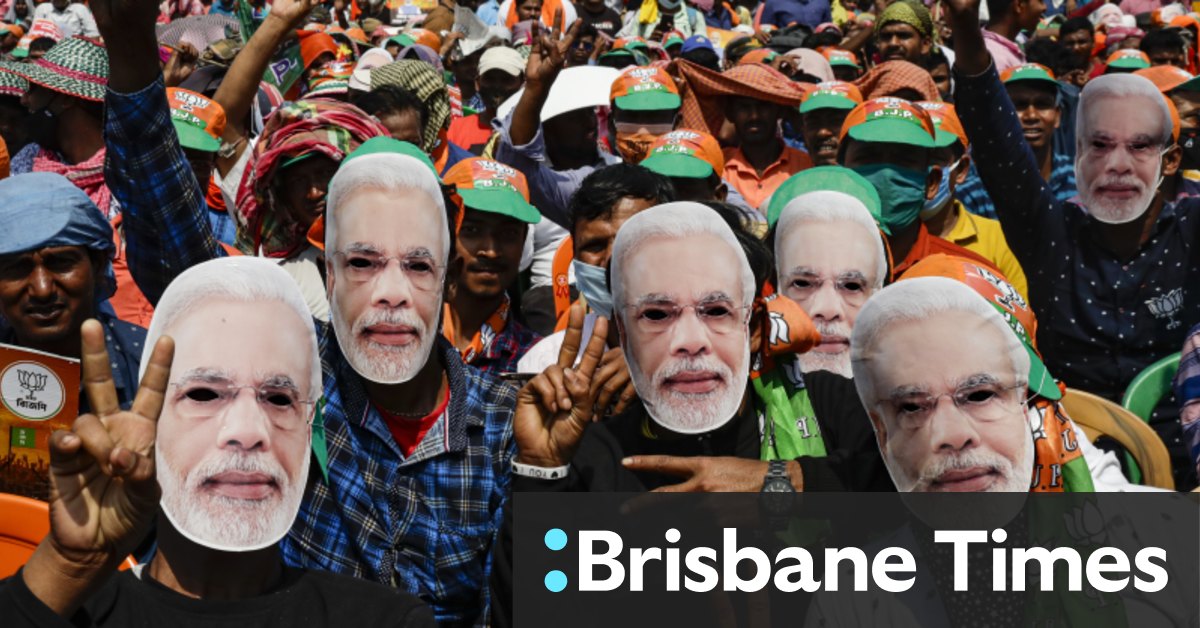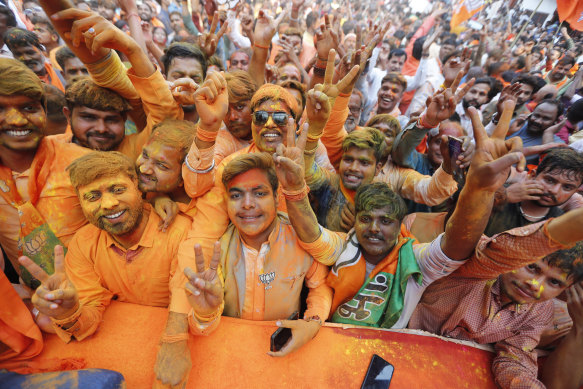The rise of the world’s largest political party

BJP dominance Rapid improvement in India-Australia relationsThe Quadrilateral Security Dialogue (Quad), which includes India, Australia, Japan and the United States, has been revived and is an important pillar of Australia’s foreign policy. Earlier this year, India and Australia signed a landmark trade agreement promising to boost trade.
Still, the BJP is relatively unknown in Australia, especially when compared to the Chinese Communist Party. So how did the BJP become a political hit?
BJP’s imposing headquarters in downtown Delhi is a testament to its success.credit:Matt Wade
Modi’s popularity and the BJP’s aggressive pro-Hindu politics have become key assets for the election.But political scientist and journalist Narin Mehta argues in his new book New BJP The party’s electoral success runs much deeper.
Once seen as an urban-based political party for upper-caste voters, the BJP has now succeeded in extending its appeal to lower-caste and other social groups at the village level.
“The BJP has become the most socially representative party in North India, apart from Muslims,” says Mehta. “The BJP’s electoral victory was also notable for seats reserved for Dalit (formerly known as untouchables) and tribal (or indigenous) peoples. The BJP has expanded politically further into geographically new areas like northeast India, where Christian voters are important and in some states a majority.”
To achieve this, the BJP brought together party cadres and local candidates from various social backgrounds, including women. It also uses welfare programs focused on housing, sanitation and domestic gas supply to create a new voter beneficiary class called “labharthis” to target female voters.
“They have really changed the playing field, which is one of the reasons more women are voting for them, especially in rural areas,” says Mehta.
Dr Vinay Sahasrabuddhe, former vice-president of the BJP, maintains that all party members have the opportunity to advance within the party.
“The BJP is a party of committed and credible leaders, and perhaps the only party that talks about the politics of performance through good governance and development,” he says.
“In the BJP, unlike most other parties, any of our volunteers can reach the highest position in the party. Joining the BJP is a very attractive proposition.”
Sahasrabuddhi, who has been personally involved in the BJP’s membership drive, said that a distinguishing feature of the BJP is that its members are “not just formal, but active.”
India has experienced a digital revolution in the last decade, facilitated by extremely cheap mobile phone data. The BJP skillfully uses this tool to recruit new party members, monitor party operations, mobilize voter support, and attack political opponents.
Mehta argues that the BJP’s sophisticated use of digital technology, especially social media, is at the “core” of what has turned it into the world’s largest political party.
“By leveraging digital technology, party leaders can now organize large-scale campaigns and validate expansion in ways never before possible,” he wrote.
Salvatore Babones, a political sociologist at the University of Sydney who studies Indian democracy, says the BJP has been able to combine deep cultural ties with the Indian community with contemporary scientific political strategies.
“It’s organic and modern at the same time, so it’s successful,” he says.
BJP’s surge in membership is the result of two major membership campaigns in 2014 and 2019.

Workers of the Bharatiya Janata Party (BJP) celebrate in Lucknow, India, ahead of the March 2022 election results.credit:APs
Despite allegations that the BJP’s membership data are exaggerated, Mehta noted that the party is “20% larger than the Chinese Communist Party,” even though one-third of the party’s membership is temporary. There is
The BJP has achieved impressive membership despite a large number of alternative political parties. India is the world’s largest democracy, with more than 900 million registered voters in her last general election.
“The big difference between the CCP and the BJP is that Chinese party cadres belong to a one-party dictatorship. “On the other hand, the expansion of the BJP in India is within a multi-party democratic system. That’s why the BJP’s cadre expansion on this scale is staggering in India, which could suffer an election reversal.”
Enthusiasm for the BJP extends far beyond India’s borders. Jay Shah, his IT consultant in Melbourne, is the president of BJP Australia’s Overseas Friends and is part of the party’s international network of ‘support and sympathy’.
“We are all volunteers,” he says. “We do this as a passion.”
The Shah has traveled to India to support the BJP’s campaign before the last two general elections in 2014 and 2019.
“A lot of people, like me, went to parties and worked out,” he says.

Atal Bihari Vajpayee was the party’s first prime minister.credit:APs
The BJP was founded in 1980 and gained electoral momentum in the 1990s. The party’s first prime minister, Atal Bihari Vajpayee, led a series of coalition governments from 1996 until he ran into 2004. Modi’s election victory in 2014 made the BJP the first political party in 30 years to win a national parliamentary majority.
The Modi government has introduced some significant economic changes including the Goods and Services Tax (GST). While this has simplified India’s fragmented indirect tax network, some have been disappointed by the slow pace of major reforms. As relations with China deteriorate, Modi has sought to deepen ties with other Indo-Pacific countries, including the United States and Australia.
However, international indicators show that India’s democratic health has declined since the BJP was launched in 2014.
The 2022 “Freedom in the World” report by Freedom House, a U.S. government-funded think tank, states: India has declined For the last 10 years.
“India is a multi-party democracy, but the government, led by Prime Minister Narendra Modi and his Hindu nationalist Bharatiya Janata Party, presides over discriminatory policies and influences on Muslims. It has increased persecution,” the paper said.
India has over 100,000 newspapers (including 36,000 weekly) and over 350 TV news channels, but the latest Global Press Freedom Index produced by media watchdog Reporters Without Borders puts We found that India’s press freedom ranking dropped in 2018. Media partisanship and a growing concentration of media ownership are reasons for the decline.
India’s Minister of Information and Broadcasting, Anurag Thakur, denied the report’s findings and said its methodology was “questionable and opaque”. He said the government is committed to ensuring the rights to freedom of speech and expression enshrined in the Indian constitution.
Still, the Economist Intelligence Unit’s annual report democracy index India’s rankings show a significant decline since peaking in 2014 when the BJP took office.
Loading
The unit’s latest report said, “The quality of democracy has seriously declined under Narendra Modi’s leadership,” and Modi’s Hindu nationalist Bharatiya Janata party has said that Muslims and Presiding over an increase in intolerance and sectarianism towards other religious minorities, and downplaying the persecution of religious and other minorities by Hindu nationalists weighs heavily on India’s democracy scores. continue. ”
To rise from the frontiers of Indian politics to become the world’s largest political party is an amazing achievement. But can Indian democracy thrive with a political giant like the BJP?
Matt Wade visited India to attend the Australia India Leadership Dialogue as a guest of the Australia India Institute.
The Morning Edition newsletter is your guide to the day’s most important and interesting articles, analysis and insights. SIGN UP HERE.
The rise of the world’s largest political party
Source link The rise of the world’s largest political party






